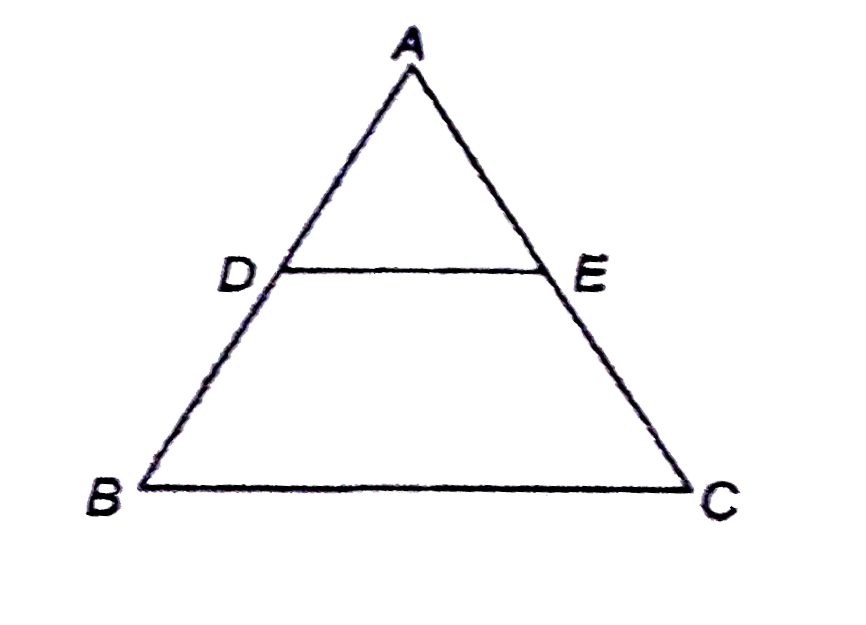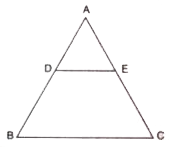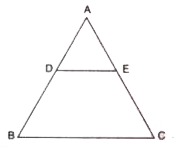P and Q are points on the sides AB and AC respectively of a △ABC. If AP= 2cm, PB = 4cm AQ= 3cm and QC= 6cm. Show that BC= 3PQ.
To solve the problem step by step, we will use the properties of similar triangles.
Step 1: Calculate the lengths of sides AB and AC.
- Given:
- AP = 2 cm
- PB = 4 cm
- AQ = 3 cm
- QC = 6 cm
- We find:
- AB = AP + PB = 2 cm + 4 cm = 6 cm
- AC = AQ + QC = 3 cm + 6 cm = 9 cm
Step 2: Find the ratios of segments on sides AB and AC.
- We calculate the ratios:
- AP / PB = 2 / 4 = 1 / 2
- AQ / QC = 3 / 6 = 1 / 2
Step 3: Establish similarity of triangles.
- Since AP / PB = AQ / QC and both triangles share angle A (angle A = angle A), we can conclude that triangle APQ is similar to triangle ABC by the SAS (Side-Angle-Side) similarity criterion.
Step 4: Set up the proportion based on the similarity of triangles.
- From the similarity of triangles, we have:
- AP / AB = PQ / BC = AQ / AC
- We can express this as:
- PQ / BC = AP / AB = AQ / AC
Step 5: Substitute the known values into the proportion.
- We know:
- AP = 2 cm, AB = 6 cm, AQ = 3 cm, AC = 9 cm
- Therefore:
- PQ / BC = 2 / 6 = 1 / 3
- Also, AQ / AC = 3 / 9 = 1 / 3
Step 6: Solve for BC in terms of PQ.
- From the proportion PQ / BC = 1 / 3, we can rearrange it to find BC:
- BC = 3 * PQ
Thus, we have shown that BC = 3PQ.
- Given:
- AP = 2 cm
- PB = 4 cm
- AQ = 3 cm
- QC = 6 cm
- We find:
- AB = AP + PB = 2 cm + 4 cm = 6 cm
- AC = AQ + QC = 3 cm + 6 cm = 9 cm
- We calculate the ratios:
- AP / PB = 2 / 4 = 1 / 2
- AQ / QC = 3 / 6 = 1 / 2
- Since AP / PB = AQ / QC and both triangles share angle A (angle A = angle A), we can conclude that triangle APQ is similar to triangle ABC by the SAS (Side-Angle-Side) similarity criterion.
- From the similarity of triangles, we have:
- AP / AB = PQ / BC = AQ / AC
- We can express this as:
- PQ / BC = AP / AB = AQ / AC
- We know:
- AP = 2 cm, AB = 6 cm, AQ = 3 cm, AC = 9 cm
- Therefore:
- PQ / BC = 2 / 6 = 1 / 3
- Also, AQ / AC = 3 / 9 = 1 / 3
- From the proportion PQ / BC = 1 / 3, we can rearrange it to find BC:
- BC = 3 * PQ
Topper's Solved these Questions
- TRIANGLES BOOK - NAGEEN PRAKASHAN ENGLISHCHAPTER - TRIANGLES EXERCISE - Exercise 6c
10 Videos
- TRIANGLES BOOK - NAGEEN PRAKASHAN ENGLISHCHAPTER - TRIANGLES EXERCISE - Exercise 6d
27 Videos
- TRIANGLES BOOK - NAGEEN PRAKASHAN ENGLISHCHAPTER - TRIANGLES EXERCISE - Eercise 6b
1 Videos
- STATISTICS BOOK - NAGEEN PRAKASHAN ENGLISHCHAPTER - STATISTICS EXERCISE - Revision Exercise Long Answer Questions
4 Videos
- VOLUME AND SURFACE AREA OF SOLIDSBOOK - NAGEEN PRAKASHAN ENGLISHCHAPTER - VOLUME AND SURFACE AREA OF SOLIDSEXERCISE - Revisions Exercise Long Answer Questions
5 Videos
Similar Questions
If P and Q are points on the sides AB and AC respeactively of △ABC, if PQ||BC,l AP= 2 cm , AB = 6 cm and AC= 9 cm find AQ.
View SolutionX and Y are points on the sides AB and AC respectively of a triangle ABC such that AX/AB=1/4, AY = 2 cm and YC = 6 cm. Find whether XY || BC or not
View Solutionif D and E are points on the sides AB and AC of a ΔABC. Such that AB=12 cm, AD=8 cm, AE=12 cm, AC= 18 cm. show that DE||BC.
View SolutionIn ΔABC,D and E are points on the sides AB and AC respectively. Find whether DE||BC if
(i) AD= 3cm , BD = 4.5cm, AE = 4cm, AC= 10cm
(ii) AB=7 cm , BD = 4.5cm, AE = 3.5 cm, CE= 5.6cm.

View SolutionIn ΔABC, D and E are points on the sides AB and AC respectively. Find whether DE//BC, if :

AD=7cm, BD=45cm,AE=35cm and CE=56cm
View SolutionM and N are points on sides AC and BC respectively of a △ABC. State whether MN||BA if CM = 4.2 cm, MA= 2.8 cm , NB = 3.6 cm, CN = 5.7 cm.
View SolutionIn ΔABC, D and E are points on the sides AB and AC respectively. Find whether DE//BC, if :

AD=3cm, BD=4.5cm,AE=4cm and AC=10cm
View SolutionIn ΔABC,D and E are the points on sides AB and AC respectively.
Find whether DE || BC, if :
AB = 9 cm, AD = 4 cm, AE = 6 cm and EC = 7.5 cm.
View SolutionD and E are respectively the points on the sides AB and AC of a triangle ABC such that AD = 2cm, BD = 3 cm, BC = 7.5 cm and DE | | BC. Then, length of DE (in cm) is
(a) 2.5
(b) 3
(c) 5
(d) 6
View SolutionP,Q,R are the points on the sides AB, BC and CA respectively of triangle ABC such that AP:PB=BQ:QC=AR:RC=1:2. Show that PBQR is a parallelogram.
View Solution
